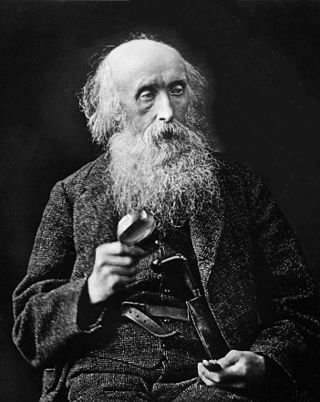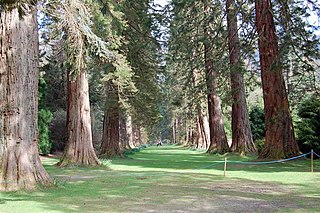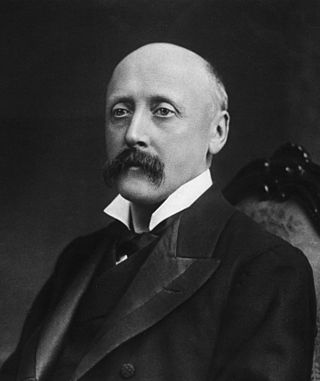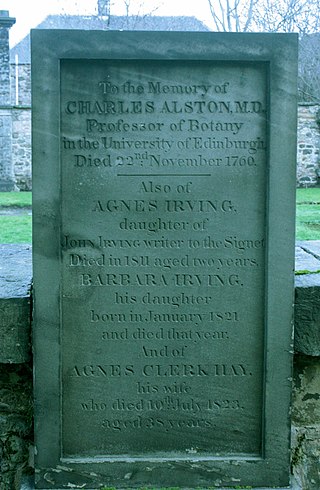
John Hutton Balfour was a Scottish botanist. Balfour became a Professor of Botany, first at the University of Glasgow in 1841, moving to the University of Edinburgh and also becoming the 7th Regius Keeper of the Royal Botanic Garden Edinburgh and Her Majesty's Botanist in 1845. He held these posts until his retirement in 1879. He was nicknamed Woody Fibre.

William Roxburgh FRSE FRCPE FLS was a Scottish surgeon and botanist who worked extensively in India, describing species and working on economic botany. He is known as the founding father of Indian botany. He published numerous works on Indian botany, illustrated by careful drawings made by Indian artists and accompanied by taxonomic descriptions of many plant species. Apart from the numerous species that he named, many species were named in his honour by his collaborators. He was the first to document the existence of the Ganges river dolphin.

The Royal Botanic Garden Edinburgh (RBGE) is a scientific centre for the study of plants, their diversity and conservation, as well as a popular tourist attraction. Founded in 1670 as a physic garden to grow medicinal plants, today it occupies four sites across Scotland—Edinburgh, Dawyck, Logan and Benmore—each with its own specialist collection. The RBGE's living collection consists of more than 13,302 plant species, whilst the herbarium contains in excess of 3 million preserved specimens.

Benmore Botanic Garden is a large botanical garden situated in Strath Eachaig at the foot of Beinn Mhòr, on the Cowal Peninsula, in Argyll and Bute, west of Scotland. The gardens are on the west side of the A815 road from Dunoon, between the Holy Loch and Loch Eck, and include footbridges across the River Eachaig. It is one of the sites of Royal Botanic Garden Edinburgh.

Sir Isaac Bayley Balfour, KBE, FRS, FRSE was a Scottish botanist. He was Regius Professor of Botany at the University of Glasgow from 1879 to 1885, Sherardian Professor of Botany at the University of Oxford from 1884 to 1888, and Professor of Botany at the University of Edinburgh from 1888 to 1922.

Charles Alston was a Scottish botanist.

Robert Graham was a Scottish physician and botanist.
The Wernerian Natural History Society, commonly abbreviated as the Wernerian Society, was a learned society interested in the broad field of natural history, and saw papers presented on various topics such as mineralogy, plants, insects, and scholarly expeditions. The Society was an offshoot of the Royal Society of Edinburgh, and from its beginnings it was a rather elite organization.
Events from the year 1699 in the Kingdom of Scotland.
Sir William Wright Smith was a Scottish botanist and horticulturalist.
William Arthur was a Scottish doctor who served as Regius Keeper of the Royal Botanic Garden and King's Botanist at Edinburgh. Shortly afterwards he was deeply implicated in the Jacobite rising of 1715. He fled to Italy, where he died the following year "from a surfeit of figs."

Professor John Hope was a Scottish physician and botanist. He did enormous work on plant classification and plant physiology, and is now best known as an early supporter of Carl Linnaeus's system of classification. He did not publish much.
James Sutherland was the first Professor of Physic (Botany) at the University of Edinburgh, from 1676 to 1705. He was intendant of the Physic Garden, and his innovative publication Hortus Medicus Edinburgensis placed Scotland at the forefront of European botany. He was also a renowned coin collector.
The Botanical Society of Scotland (BSS) is the national learned society for botanists of Scotland. The Society's aims are to advance knowledge and appreciation of flowering and cryptogamic plants, algae and fungi. The Society's activities include lectures, symposia, field excursions, field projects and an annual Scottish Botanist's Conference, held jointly with the Botanical Society of Britain and Ireland for exchange of information between botanists working in different areas. Its publications include a twice-yearly newsletter, BSS News, and a scientific journal, Plant Ecology & Diversity. The society is closely linked to the Royal Botanic Garden Edinburgh and the Scottish universities.

Stephen Blackmore CBE FRSE Royal Society of Biology FLS is a British botanist, who was educated at St. George's School, Hong Kong and the University of Reading where he completed his PhD in 1976 on the "Palynology and Systematics of the Cichorieae". He was elected a fellow of the Linnean Society of London in 1976. He then worked at the Royal Society of London’s Research Station on Aldabra Atoll in the Indian Ocean before being appointed Lecturer in Biology and Head of the National Herbarium and Botanic Garden at the University of Malawi. In 1980, he was appointed Head of Palynology at Natural History Museum in London and from 1990 to 1999 served there as Keeper of Botany. In 1985 he organized, together with Keith Ferguson, the Linnean Society symposium "Pollen and Spores: Form and Function" and in 1990, together with Susan Barnes, "Pollen and Spores: Patterns of Diversification". He was the 15th Regius Keeper of the Royal Botanic Garden Edinburgh from 1999 until 20 December 2013, and was appointed His Majesty's Botanist in Scotland in 2010.
William Grant Craib was a British botanist. Craib was Regius Professor of Botany at Aberdeen University and later worked at the Royal Botanic Gardens, Kew.

Sir Francis Arthur Aglen was a servant of the Chinese Imperial Customs, later to be the Chinese Maritime Customs, rising through the service to become Inspector-General of the Chinese Maritime Customs Service from 1911 to 1927 after the death of Sir Robert Hart.
The Royal status of the Royal Botanic Garden Edinburgh (RBGE) is intrinsically linked to the issue of a Royal Warrant to the first Intendant of the Gardens in 1699. Since that date, the appointment of each new Director of RBGE has required the assent of the reigning monarch of the United Kingdom, the appointee receiving the unique title RegiusKeeper.

Francis Chalmers Crawford FRSE (1851–1908) was a Scottish stockbroker of fame as an amateur botanist and ornithologist. Saxifraga crawfordii is named after him. He served as President of the Scottish Microscopical Society.

Robert Moyes Adam was a Scottish photographer and botanist known for his work with the Royal Botanic Garden Edinburgh.











